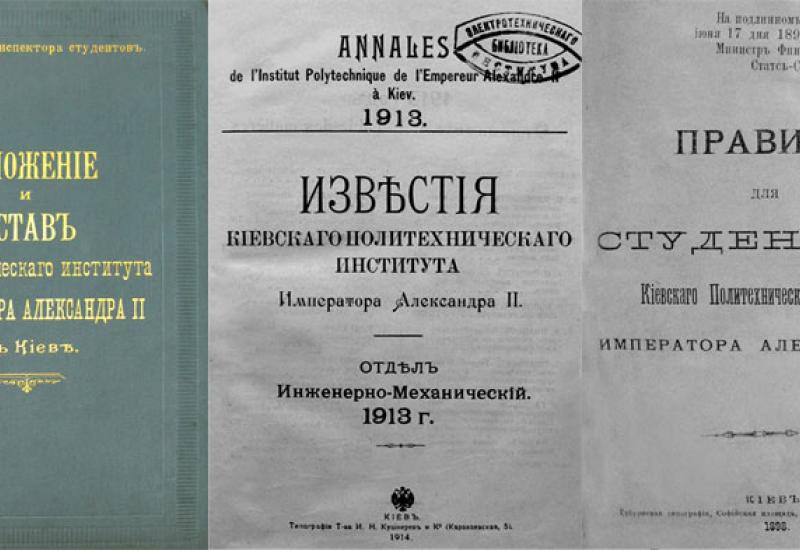Researchers who research institutions of higher learning usually emphasize new scientific schools and personalia, cultural events, etc. But the educational process is impossible without printed materials.
Since 1898 – since the founding of KPI, that is – the scientific achievements of the professors and teaching staff were published in different publishing houses around Kyiv, such as the Kyiv-Galych Publishing, Kiev Governorate Publishing, I. Kushnaryov & Co. Association, S. Kulzhenko, S. Spyliotti, I. Chokolov's “Worker” publishing house, etc. To publish textbooks at the institute's expense, special “Licence for Allowance for Institute Professors to Publish Lectures” were given, signed by the institute director. This is supported by the teachers' letters to the institute administration begging “to allow assignation of funds” to print lectures. For example, Professor G. de Metz asked permission to print a textbook for the “Physical Measurements” course. His letter was added to the publishing plan, and he had the possibility to publish from January 21st, 1899. Professor Y. Wagner, on March 17th, 1899, received a license to publish lectures on zoology in the M.I. Tymoshenko & Co. Publishing House.
Publishing houses and authors signed contracts regulating the use of paper, the cost of publication, the number of pages printed, and the volume published, which was handed out to the subscribers and institute administration members. Copies of publications were given to the library and the authors.
By order of the institute directors various documents were printed for KPI, and later became main official sources which regulated activity and organization of studies, for example, the “Regulations and Statute of the Emperor Alexander II Kiev Polytechnic Institute”, “Regulations for Students”, “Outlay”, “Manning Table”, “Inspections Instruction”, “Reports”, course programs and others.
From November the 17th, 1900, Institute Council began correspondence with several Kyiv publishers to print the Izvestiya KPI paper, more precisely, with the P. Barsky Publishing House, I. Chokolov Publishing House (agreed to publish from April 10th, 1901), S. Kulzhenko Publishing House (published the Izvestiya KPI from December 31st, 1902, to April 1903), and V. Uvarov Lithography.
To supply the educational process, on November 17, 1900, KPI rector V. Kirpichov adressed the Trade Department of the Minister of Finance for a permission to publish the best scientific papers in a collection named “Izvestiya KPI”, attaching the publication programme. The Institute Council planned to begin publishing the “special journal of the institute, named “the Izvestiya (News) of the Emperor Alexander II Kiev Polytechnical Institute”, where papers by professors, teachers and sometimes “persons outside the institute” would be printed, and where yearly reports and other official data would be published. Details and regulations, together with the publication's editors, were agreed with the Chief Administration of Publishing Affairs.
The institute's publishing was regulated by norms and demands put before a scientific collection, the “Regulations, Publishers' Correspondence and Other Materials on the Publication of the “Izvestiya” of the Emperor Alexander II Kiev Polytechnical Institute”, dated November 17, 1900, and the “Izvestiya KPI Publication Program” approved by the Minister of Finance.
On March 14, 1901, the Chief Administration of Publishing Affairs gave the Emperor Alexander II Kiev Polytechnic Institute the License № 2165, “that it is a Publisher of a journal “Izvestiya KPI” and approved for release in the City of Kiev without prior censorship”.
The correspondence between the institute administration and the administration of the S. Kulzhenko Publishing House indicate that it was the first to offer to publish the journal. The Izvestiya KPI were designed following the example of the “Moscow Agricultural Institute Herald”, which was printed in different typesets, but the main part of the journal was printed in the typeset most abundant in the text, like Cicero, Grove-Cicero, Mittel, Garmont, Petito and others. For printing foreign letters a 15% increase in cost was approved, 40% for mathematical formulae, and by a mutual agreement – for authorial corrections. The first issues of the magazine were published thrice a year in 10 printed pages, with a 800 copies' edition.
The St. Volodymyr University Printing, Lithography and Binding, together with N. Korchak-Novytskyi Joint Stock Company, offered help in signing the printing contract for the “Izvestiya KPI”. For the publication, a 5% cut was arranged for printing; for example, every thousand letters costed 30 kopeks (except mathematics and foreign language texts), every table – 50 kopeks, binding a thousand copies of one to three pages – 1 kop., three to six thousand pages – 2 kop., six to ten thousand pages – 3 kop., ten to fifteen thousand pages – 4 kop. For students one copy was 12 rubles. The contract was signed for a term of three years to be later prolonged by the Institute Council.
In the Chief Administration of Publishing Affairs inventory the “Izdatelstvo Izvestiy KPI” publishing house was marked as located in Kyiv, Brest-Litovskyi Avenue, 39 (main institute building). At the time the publishing house didn't have their own printing and bookshop, only had an editorial commission, and was an enterprise. The yearly publishing plan was five or six books of 10 printed pages each, with a 10 points' interval.
These facts state, therefore, the “Izdatelstvo Izvestiy KPI” was formed in 1900. Since the institute had no publishing base of its own, the Izvestiya KPI journal was printed in different publishing houses of the city up until 1924.
By reviewing the official and educational literature of the 1898-1924 period and analyzing archived documents, we can state that November the 17th, 1900 should be said to be the date the “Izdatelstvo Izvestiy KPI” was created. Several other publishers emerged in the institute later, like “Engineering Club Publishing”, “Mechanical Club Publishing”, “Students' Aid Fund Publishing” and the “Ukrainian KPI Technical Publishing”, which all played a great role at developing publishing and the institute's evolution as a whole.
Galyna Ivanivna Loza, Head of the PPI VPK Politekhnika publishing laboratory
Translator: Нікіта Соловйов ЛА-11

